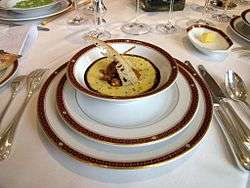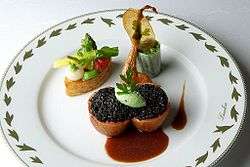Haute cuisine

Haute cuisine (French: literally "high cooking", pronounced: [ot kɥi.zin]) or Grande cuisine refers to the cuisine of "high level" establishments, gourmet restaurants and luxury hotels. Haute cuisine is characterized by meticulous preparation and careful presentation of food, at a high price level, perhaps accompanied by expensive wines.
History
Haute cuisine was characterized by French cuisine in elaborate preparations and presentations served in small and numerous courses that were produced by large and hierarchical staffs at the grand restaurants and hotels of Europe.
The 17th century chef and writer La Varenne marked a change from cookery known in the Middle Ages, to somewhat lighter dishes, and more modest presentations. In the following century, Antonin Carême, born in 1784, also published works on cooking, and although many of his preparations today seem extravagant, he simplified and codified an earlier and even more complex cuisine.
Georges Auguste Escoffier is a central figure in the modernisation of haute cuisine as of about 1900, which became known as cuisine classique. These were simplifications and refinements of the early work of Carême, Jules Gouffé and Urbain Dubois. It was practised in the grand restaurants and hotels of Europe and elsewhere for much of the 20th century. The major developments were to replace service à la française (serving all dishes at once) with service à la russe (serving meals in courses) and to develop a system of cookery, based on Escoffier's Le Guide Culinaire, which formalized the preparation of sauces and dishes. In its time, it was considered the pinnacle of haute cuisine, and was a style distinct from cuisine bourgeoise (cuisine for families with cooks), the working-class cuisine of bistros and homes, and cuisines of the French provinces.

The 1960s were marked by the appearance of nouvelle cuisine, as chefs rebelled from Escoffier's "orthodoxy" and complexity. Although the term nouvelle cuisine had been used in the past, the modern usage can be attributed to authors André Gayot,[1] Henri Gault, and Christian Millau, who used nouvelle cuisine to describe the cooking of Paul Bocuse, Alain Chapel, Jean and Pierre Troisgros, Michel Guérard, Roger Vergé and Raymond Oliver, many of whom were once students of Fernand Point.[2]
In general, nouvelle cuisine puts an emphasis on natural flavours, so the freshest possible ingredients are used, preparation is simplified, heavy sauces are less common, as are strong marinades for meat, and cooking times are often reduced. While menus were increasingly short, dishes used more inventive pairings and relied on inspiration from regional dishes.[2]
Within 20 years, however, chefs began returning to the earlier style of haute cuisine, although many of the new techniques remained.[2]
References
| Look up haute cuisine in Wiktionary, the free dictionary. |
Further reading
- Cooking, Cuisine and Class, A Study in Comparative Sociology, Jack Goody, University of Cambridge, June 1982, ISBN 978-0-521-28696-1
- Food and love: a cultural history of East and West By Jack Goody, Verso (April 1999), ISBN 978-1-859-84829-6
- Tasting food, tasting freedom: excursions into eating, culture, and the past by Sidney Wilfred Mintz Beacon Press (1997) - ISBN 0-8070-4629-9
- Viandier attributed to Guillaume Tirel dit Taillevent, medieval manuscript
- Haute Cuisine: How the French Invented the Culinary Profession By Amy B. Trubek, University of Pennsylvania Press (December 2000), ISBN 978-0-8122-1776-6
- Food culture in France By Julia Abramson, Greenwood Press (November 2006), ISBN 978-0-313-32797-1
- Patrick Rambourg, Histoire de la cuisine et de la gastronomie françaises, Paris, Ed. Perrin (coll. tempus n° 359), 2010, 381 pages. ISBN 978-2-262-03318-7
